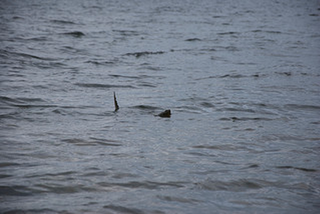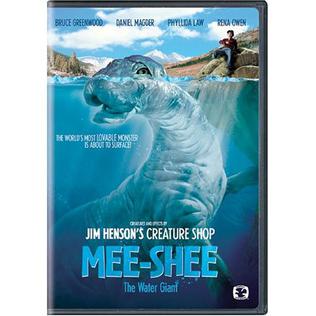
The Loch Ness Monster, affectionately known as Nessie, is a creature in Scottish folklore that is said to inhabit Loch Ness in the Scottish Highlands. It is often described as large, long-necked, and with one or more humps protruding from the water. Popular interest and belief in the creature has varied since it was brought to worldwide attention in 1933. Evidence of its existence is anecdotal with a number of disputed photographs and sonar readings.

Sea monsters are beings from folklore believed to dwell in the sea and are often imagined to be of immense size. Marine monsters can take many forms, including sea dragons, sea serpents, or tentacled beasts. They can be slimy and scaly and are often pictured threatening ships or spouting jets of water. The definition of a "monster" is subjective; further, some sea monsters may have been based on scientifically accepted creatures, such as whales and types of giant and colossal squid.

A lake monster is a lake-dwelling entity in folklore. The most famous example is the Loch Ness Monster. Depictions of lake monsters are often similar to those of sea monsters.
Lake Tianchi Monster is the name given to what is said to be a lake monster that lives in Heaven Lake located in the peak of Baekdu Mountain within the Baekdu-daegan and Changbai mountain ranges encompassing Jilin Province of China and Ryanggang Province of North Korea. According to Beijing Youth Daily, an estimated 20 monsters were reported, however "scientists are skeptical that any large creature would be able to survive in the lake given its recent history of volcanic activity", and skeptics say "it's all in the imagination, or just a floating volcanic rock".

In Canadian folklore, the Ogopogo is a lake monster said to inhabit Okanagan Lake in British Columbia, Canada. Some scholars have charted the entity's development from First Nations folklore and widespread water monster folklore motifs. The Ogopogo now plays a role in the commercial symbolism and media representation of the region.

Okanagan Lake is a lake in the Okanagan Valley of British Columbia, Canada. The lake is 135 km (84 mi) long, between 4 and 5 km wide, and has a surface area of 348 km2.

Walter Moberly (1832–1915) was a civil engineer and surveyor who played a large role in the early exploration and development of British Columbia, Canada, including discovering Eagle Pass, now used by the Canadian Pacific Railway and the Trans-Canada Highway.
In Canadian folklore, the Manipogo is a lake monster said to live in Lake Manitoba, Manitoba, Canada. The creature was dubbed Manipogo in 1960, the name echoing British Columbia's Ogopogo. There is also a Lake Winnipegosis monster called Winnepogo, thought possibly to be the same creature since the lakes are connected. It is the namesake of the Manipogo Provincial Park.

In American folklore, Champ or Champy is the name of a lake monster said to live in Lake Champlain, a 125-mile (201 km)-long body of fresh water shared by New York and Vermont, with a portion extending into Quebec, Canada. The legend of the monster is considered a draw for tourism in the Burlington, Vermont and Plattsburgh, New York areas.

In Canadian folklore, Mussie is a creature said to live in Muskrat Lake in the Canadian province of Ontario. It is variously described, for example, as a walrus or as a three-eyed Loch Ness Monster-like creature.The legend of Mussie likely began around 1916, though legend claims that Canadian pioneer Samuel de Champlain wrote about it in the early seventeenth century. Mussie has become a part of the local culture and a fixture in the local tourism industry.
Cottage country is a common name in Ontario, New Brunswick, and other regions of Canada for areas that are popular locations for recreational properties such as cottages and summer homes. Cottage country is often socially, culturally, economically, and politically distinct from other rural areas in that it is populated by a notably higher concentration of urban vacationers and residents who have an affinity for the outdoors, in contrast to more traditional rural populations, which are largely absent of "city folk", but that is less true in Western Canada. Any major population centre may have its own popular "cottage country" area.

In Canadian folklore, Memphre is a lake monster said to live in Lake Memphremagog, a fresh water glacial lake located between Newport, Vermont, United States and Magog, Quebec, Canada.

Mee-Shee: The Water Giant is a British-German family film shot in New Zealand in 2002 and released in 2005. It stars Bruce Greenwood, Rena Owen, Tom Jackson and Daniel Magder.
In Italian folklore, Lariosauro is a lake monster said to live in Lake Como in Italy, about 50 km north of Milan. Como is one of the deepest European lakes, at about 410 m at the deepest location.
In Lake Tahoe folklore, Tahoe Tessie is a creature which resides in North America's largest alpine lake, Lake Tahoe, located in Nevada and California. It is said to live in an underwater tunnel that is beneath Cave Rock. Founder of the University of California, Davis's Tahoe Research Group Charles R. Goldman attributes claimed sightings to pareidolia and the mistaken identification of a large breed of fish introduced to Lake Tahoe during trout and mackinaw plantings. The talk of Tessie is similar to the Loch Ness monster "Nessie".

A water horse is a mythical creature, such as the Ceffyl Dŵr, Capaill Uisce, the bäckahäst and kelpie.
Northern Mysteries is a docudrama-style television program that retells some of the stranger events in Canadian history, dealing with ghosts, paranormal events, lost treasures and bizarre murders. Hosted by Kenneth Welsh each episode usually tackles two events or subjects, by discussing with journalists, the police and eyewitnesses a complete account of what happened, as well as re-enacting the events for entertainment purposes.
In Montana folklore, the Flathead Lake Monster is a lake monster located in Flathead Lake in Montana.

Susan Louisa Moir Allison was a Canadian author and pioneer. In 2010 Allison was designated a National Historic Person by the Canadian Government.
In Canadian folklore, Seelkee is a lake monster reported to have lived in the swamps of what is now Chilliwack, in British Columbia, Canada. Seelkee has been allegedly seen by the Stó:lō, First Nations, people for hundreds of years. The most common description of Seelkee is a 10 to 15-foot-long sea serpent like beast with the head of a horse.












